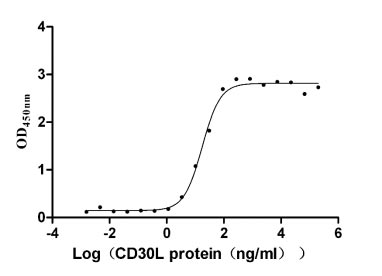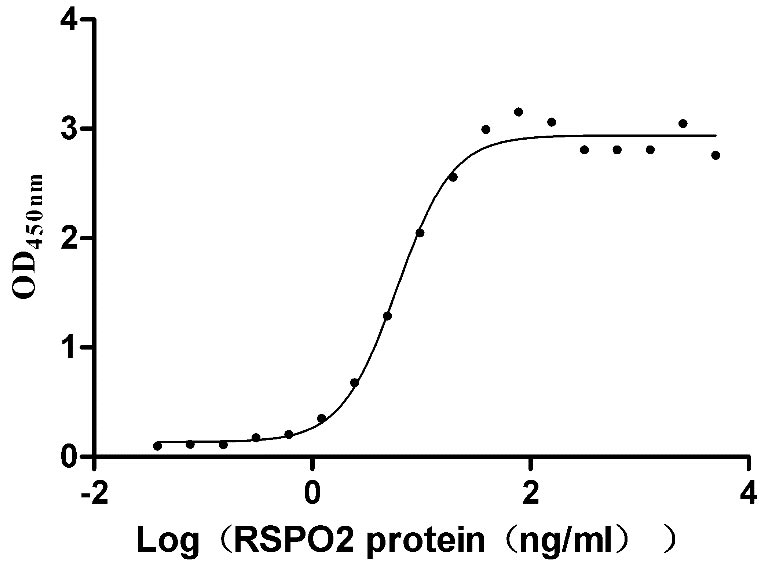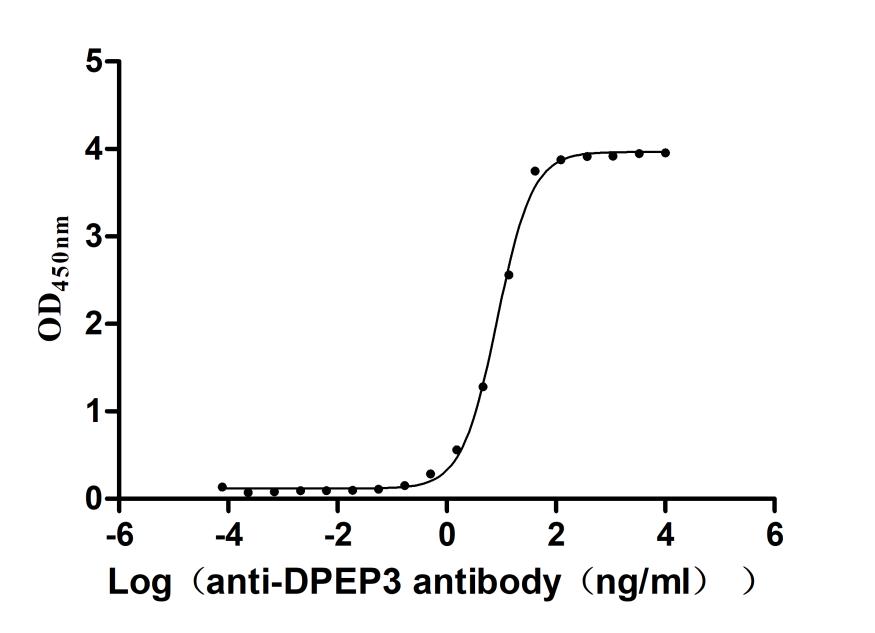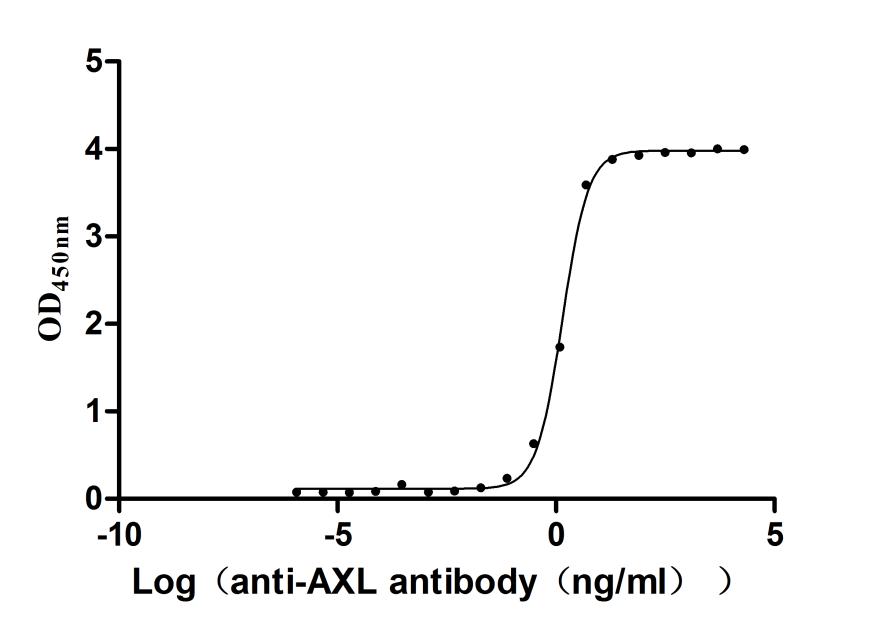Recombinant Helicobacter pylori Cytotoxicity-associated immunodominant antigen (cagA), partial
-
中文名称:Recombinant Helicobacter pylori Cytotoxicity-associated immunodominant antigen(cagA),partial
-
货号:CSB-BP345531HUV
-
规格:
-
来源:Baculovirus
-
其他:
-
中文名称:Recombinant Helicobacter pylori Cytotoxicity-associated immunodominant antigen(cagA),partial
-
货号:CSB-EP345531HUV-B
-
规格:
-
来源:E.coli
-
共轭:Avi-tag Biotinylated
E. coli biotin ligase (BirA) is highly specific in covalently attaching biotin to the 15 amino acid AviTag peptide. This recombinant protein was biotinylated in vivo by AviTag-BirA technology, which method is BriA catalyzes amide linkage between the biotin and the specific lysine of the AviTag.
-
其他:
-
中文名称:Recombinant Helicobacter pylori Cytotoxicity-associated immunodominant antigen(cagA),partial
-
货号:CSB-MP345531HUV
-
规格:
-
来源:Mammalian cell
-
其他:
产品详情
-
纯度:Greater than 85% as determined by SDS-PAGE.
-
基因名:cagA cag26 cai HP_0547
-
Uniprot No.:
-
别名:cagA; cag26; cai; HP_0547Cytotoxicity-associated immunodominant antigen; 120 kDa protein; CAG pathogenicity island protein 26
-
种属:Helicobacter pylori (strain ATCC 700392 / 26695) (Campylobacter pylori)
-
蛋白长度:Partial
-
表达区域:1-294aa
-
氨基酸序列MTNETIDQTRTPDQTQSQTAFDPQQFINNLQVAFIKVDNVVASFDPDQKPIVDKNDRDNRQAFDGISQLREEYSNKAIKNPTKKNQYFSDFIDKSNDLINKDNLIDVESSTKSFQKFGDQRYQIFTSWVSHQKDPSKINTRSIRNFMENIIQPPIPDDKEKAEFLKSAKQSFAGIIIGNQIRTDQKFMGVFDESLKERQEAEKNGGPTGGDWLDIFLSFIFNKKQSSDVKEAINQEPVPHVQPDIATTTTDIQGLPPEARDLLDERGNFSKFTLGDMEMLDVEGVADIDPNYKF
-
蛋白标签:Tag type will be determined during the manufacturing process.
The tag type will be determined during production process. If you have specified tag type, please tell us and we will develop the specified tag preferentially. -
产品提供形式:Lyophilized powder
Note: We will preferentially ship the format that we have in stock, however, if you have any special requirement for the format, please remark your requirement when placing the order, we will prepare according to your demand. -
复溶:We recommend that this vial be briefly centrifuged prior to opening to bring the contents to the bottom. Please reconstitute protein in deionized sterile water to a concentration of 0.1-1.0 mg/mL.We recommend to add 5-50% of glycerol (final concentration) and aliquot for long-term storage at -20℃/-80℃. Our default final concentration of glycerol is 50%. Customers could use it as reference.
-
储存条件:Store at -20°C/-80°C upon receipt, aliquoting is necessary for mutiple use. Avoid repeated freeze-thaw cycles.
-
保质期:The shelf life is related to many factors, storage state, buffer ingredients, storage temperature and the stability of the protein itself.
Generally, the shelf life of liquid form is 6 months at -20°C/-80°C. The shelf life of lyophilized form is 12 months at -20°C/-80°C. -
货期:Delivery time may differ from different purchasing way or location, please kindly consult your local distributors for specific delivery time.Note: All of our proteins are default shipped with normal blue ice packs, if you request to ship with dry ice, please communicate with us in advance and extra fees will be charged.
-
注意事项:Repeated freezing and thawing is not recommended. Store working aliquots at 4°C for up to one week.
-
Datasheet :Please contact us to get it.
相关产品
靶点详情
-
功能:May be necessary for the transcription, folding, export, or function of the cytotoxin.
-
基因功能参考文献:
- The authors conclude that CagQ is a membrane protein in a type IV secretion system and is crucial for maintaining CagA expression and CagA-induced apoptotic effects. PMID: 29306012
- The vacuolating cytotoxin autotransporter (vacA) c1 genotype, but not cytotoxicity-associated immunodominant antigen (cagA) status, might be the first important bacterial biomarker for predicting the cardia adenocarcinoma risk. PMID: 29036792
- In this study, through quantitative analysis of the complex formation between CagA and PAR1b, the authors found that several CagA species have acquired elevated PAR1b-binding activity via duplication of the CagA multimerization motifs, while others have lost their PAR1b-binding activity. PMID: 27445265
- Helicobacter pylori expressing cagA and vacA genes is prevalent in dyspeptic Ghanaian patients. PMID: 28655347
- H. pylori infection significantly inhibits the cleavage of TRAF1 via a CagA-dependent mechanism, which would increase the relative amounts of full-length TRAF1 and exert an antiapoptotic effect on H. pylori-infected cells. PMID: 28082808
- Data indicate that treatment of gastric epithelial cells with simvastatin reduced the level of cellular cholesterol and led to attenuation of translocation and phosphorylation of cytotoxin-associated gene A (CagA). PMID: 26730715
- Studies suggest that cytotoxin-associated gene A (CagA)-negative non-virulent strains of Helicobacter pylori may be a potential risk factor of pancreatic cancer. PMID: 26390415
- CagT plays an important role in the translocation of CagA into host epithelial cells. PMID: 23075784
- CagA upregulated CIP2A expression and this upregulation effect was dependent on Src and Ras/mitogen-activated protein kinase kinase/extracellular signal-regulated kinase pathways. PMID: 19959630
- In a stomach adenocarcinoma cell line, an increase in this protein correlated with the amount of the phosphorylated protein. PMID: 16278423
- These data demonstrate that VacA can downregulate CagA's effects on epithelial cells, a novel molecular mechanism showing how H. pylori can avoid excessive cellular damage. PMID: 19046339
显示更多
收起更多
-
数据库链接:
KEGG: heo:C694_02825
STRING: 85962.HP0547
Most popular with customers
-
Recombinant Human Tumor necrosis factor receptor superfamily member 8 (TNFRSF8), partial (Active)
Express system: Mammalian cell
Species: Homo sapiens (Human)
-
Recombinant Human E3 ubiquitin-protein ligase ZNRF3 (ZNRF3), partial (Active)
Express system: Mammalian cell
Species: Homo sapiens (Human)
-
Recombinant Macaca fascicularis Dipeptidase 3(DPEP3) (Active)
Express system: Mammalian cell
Species: Macaca fascicularis (Crab-eating macaque) (Cynomolgus monkey)
-
Recombinant Human Tyrosine-protein kinase receptor UFO(AXL),partial (Active)
Express system: Mammalian cell
Species: Homo sapiens (Human)















